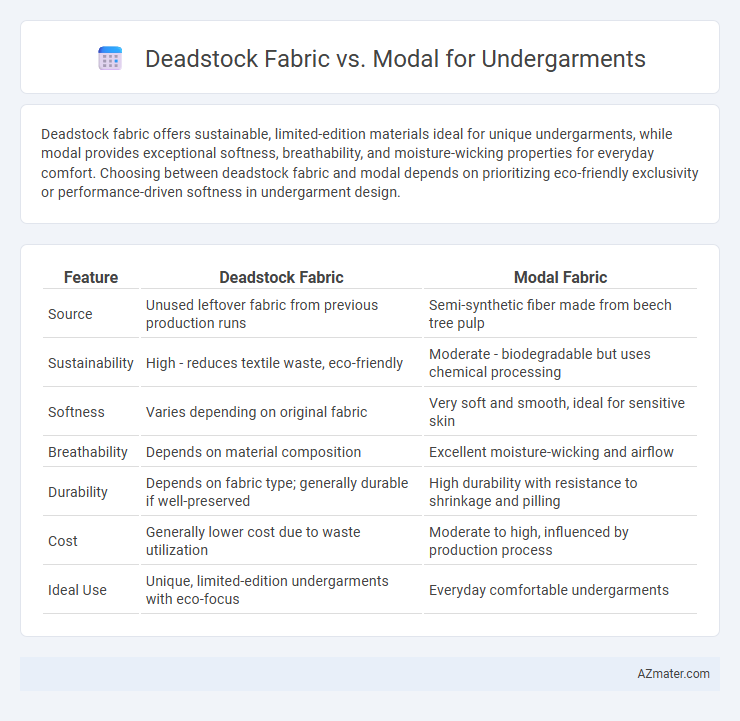Deadstock fabric offers sustainable, limited-edition materials ideal for unique undergarments, while modal provides exceptional softness, breathability, and moisture-wicking properties for everyday comfort. Choosing between deadstock fabric and modal depends on prioritizing eco-friendly exclusivity or performance-driven softness in undergarment design.
Table of Comparison
| Feature | Deadstock Fabric | Modal Fabric |
|---|---|---|
| Source | Unused leftover fabric from previous production runs | Semi-synthetic fiber made from beech tree pulp |
| Sustainability | High - reduces textile waste, eco-friendly | Moderate - biodegradable but uses chemical processing |
| Softness | Varies depending on original fabric | Very soft and smooth, ideal for sensitive skin |
| Breathability | Depends on material composition | Excellent moisture-wicking and airflow |
| Durability | Depends on fabric type; generally durable if well-preserved | High durability with resistance to shrinkage and pilling |
| Cost | Generally lower cost due to waste utilization | Moderate to high, influenced by production process |
| Ideal Use | Unique, limited-edition undergarments with eco-focus | Everyday comfortable undergarments |
Understanding Deadstock Fabric
Deadstock fabric refers to unused, surplus textile leftover from previous production runs, offering a sustainable alternative by reducing waste and environmental impact. This fabric often features unique textures and patterns unavailable in modern production, making it a rare choice for undergarments that prioritize individuality and eco-conscious sourcing. Understanding deadstock fabric's quality variations and fiber content is crucial for designing comfortable, breathable undergarments that meet performance standards comparable to Modal, a soft, moisture-wicking material derived from beech tree pulp.
What Is Modal Fabric?
Modal fabric is a type of semi-synthetic cellulose fiber made from beech tree pulp, known for its exceptional softness, breathability, and moisture-wicking properties, making it ideal for undergarments that require comfort and durability. Unlike deadstock fabric, which consists of surplus materials from previous textile runs, modal offers consistent quality and a smooth texture that enhances wearability and reduces irritation. Its eco-friendly production process and resistance to shrinkage and pilling further position modal as a preferred choice for sustainable, high-performance undergarments.
Sourcing and Availability Comparison
Deadstock fabric offers sustainable sourcing by repurposing excess or leftover textile materials from previous production runs, ensuring limited environmental impact and unique fabric choices; however, its availability is often inconsistent and limited by the volume of surplus stock. Modal, a semi-synthetic fiber derived from beech tree pulp, is widely sourced from established manufacturers with consistent supply chains, providing reliable access and scalability for undergarment production. The trade-off between deadstock's eco-conscious exclusivity and modal's dependable availability is a key consideration for brands prioritizing sustainability versus manufacturing efficiency.
Sustainability: Deadstock vs Modal
Deadstock fabric utilizes surplus textiles that would otherwise go to waste, significantly reducing landfill impact and resource consumption, making it a highly sustainable choice for undergarments. Modal, a semi-synthetic fiber derived from beech tree cellulose, offers biodegradability and lower water usage compared to conventional cotton but involves chemical processing that may affect its overall environmental footprint. Choosing deadstock fabric prioritizes circular fashion by repurposing existing materials, whereas modal supports sustainability through renewable resources and biodegradability with some manufacturing trade-offs.
Comfort and Breathability
Deadstock fabric, made from leftover or surplus textile materials, offers unique textures and limited availability while maintaining moderate breathability and comfort suitable for sustainable undergarments. Modal fabric, derived from beech tree fibers, excels in softness, moisture-wicking, and breathability, making it ideal for undergarments requiring superior comfort and temperature regulation. Choosing between deadstock fabric and modal depends on prioritizing sustainability and exclusivity versus enhanced softness and optimal airflow in undergarments.
Durability and Longevity
Deadstock fabric often features high durability due to its original manufacturing quality and unused condition, making it resistant to wear in undergarments. Modal, a semi-synthetic fiber derived from beech trees, is renowned for its softness and moisture-wicking properties but tends to have moderate longevity, showing signs of pilling and thinning after repeated washes. Choosing deadstock fabric for undergarments typically results in longer-lasting garments compared to modal, which prioritizes comfort over extended durability.
Skin Sensitivity and Allergen Considerations
Deadstock fabric, often made from natural fibers like cotton or silk, is typically untreated and less likely to contain synthetic chemicals, making it a good option for sensitive skin and individuals prone to allergies. Modal, a semi-synthetic fabric derived from beech tree pulp, is smooth and breathable but may undergo chemical processing that can irritate highly sensitive skin or trigger allergic reactions in some people. Choosing deadstock fabric reduces exposure to harsh dyes and finishes, whereas modal's softness benefits comfort but requires careful selection of chemical-free, hypoallergenic variants for undergarment use.
Price and Affordability
Deadstock fabric often comes at a lower price point due to its surplus nature, making it a cost-effective choice for undergarment production while supporting sustainable practices. Modal fabric, derived from beech tree pulp, tends to be more expensive because of its manufacturing process and luxurious softness. Brands targeting affordability usually prefer deadstock fabric to minimize costs without compromising quality, whereas modal appeals to premium markets prioritizing comfort and durability.
Design Versatility for Undergarments
Deadstock fabric offers unique design versatility for undergarments due to its wide range of textures, patterns, and limited-edition availability, enabling designers to create exclusive, one-of-a-kind pieces. Modal fabric delivers exceptional comfort and stretchability, facilitating sleek, form-fitting designs that enhance wearability and durability in everyday undergarments. Combining deadstock fabric's distinct aesthetic with modal's softness can result in innovative undergarment designs that balance style, comfort, and sustainability.
Final Verdict: Which Is Better for Undergarments?
Deadstock fabric offers unique sustainability benefits by repurposing excess textile production, while modal is prized for its softness, breathability, and moisture-wicking properties, making both materials viable for undergarments. Modal's smooth texture and durability provide superior comfort and longer-lasting wear, which often surpasses the variable quality and limited availability of deadstock fabric. For undergarments prioritizing comfort, performance, and consistent quality, modal is generally the better choice, though deadstock fabric remains an eco-friendly option for conscious consumers.

Infographic: Deadstock Fabric vs Modal for Undergarment
 azmater.com
azmater.com